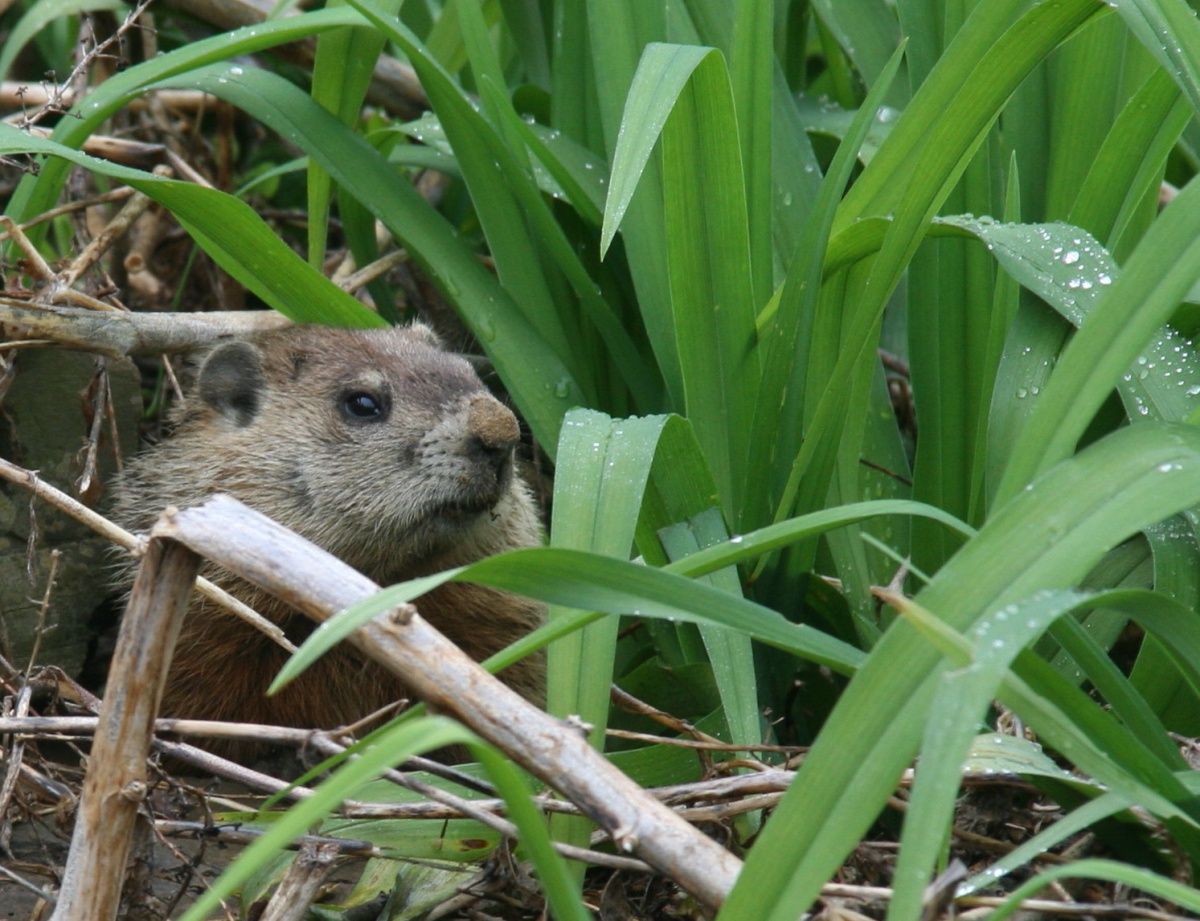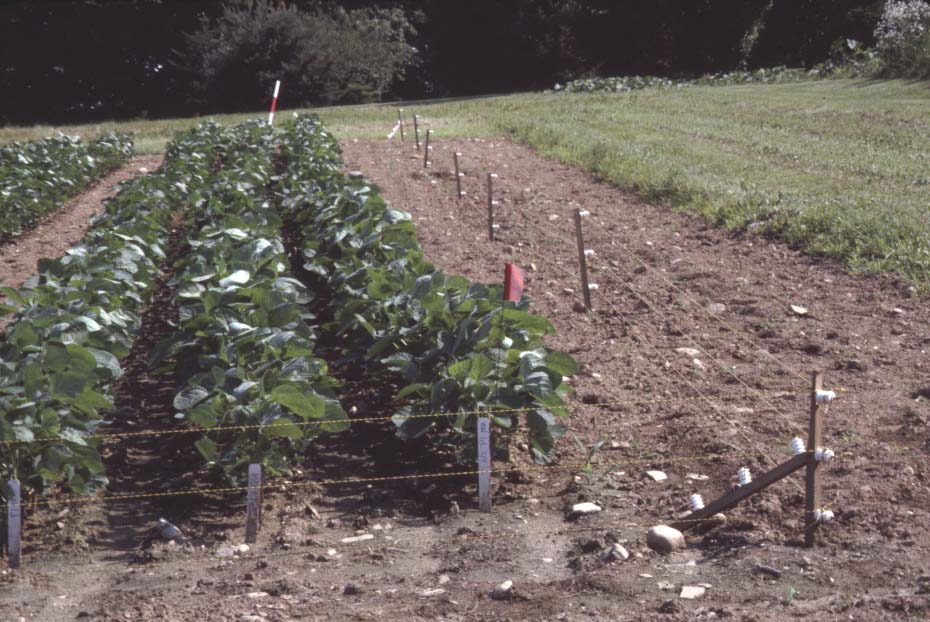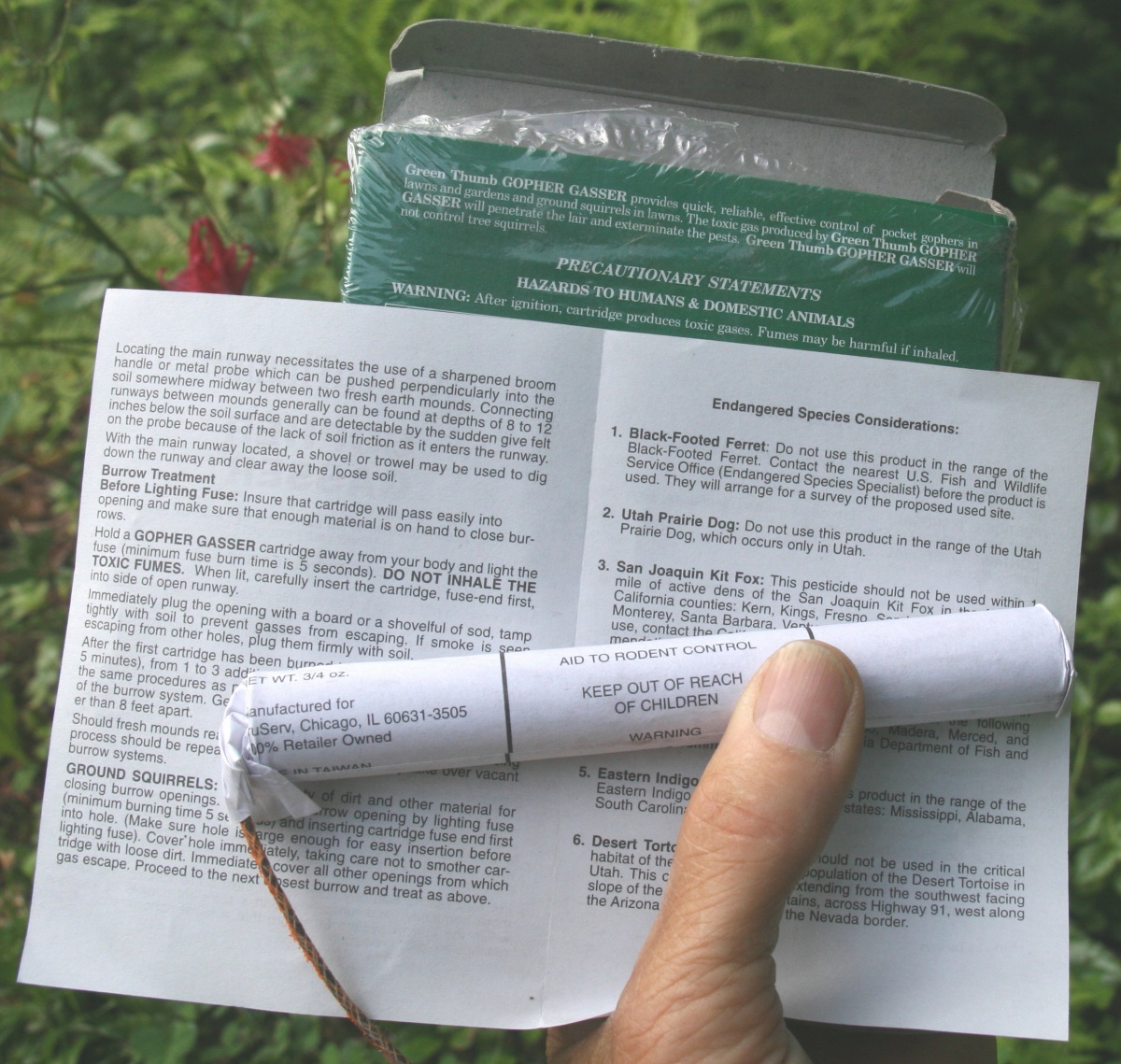Woodchucks frequently damage plants in NH home grounds and gardens. They mow down many garden plants, and dig burrows which dry out the roots of trees. Back when most NH people relied on horses, woodchucks were scorned because their hidden holes could cause a horse to trip and break a leg. No wonder we call them pests!
Before we paint them as entirely bad, we should recognize how woodchucks are valuable. They are native mammals, evolved to fit into the environment here. They dig extensive burrows that are used as escape cover, shelter, or overwintering sites by many other animals. Cottontail rabbits, skunks, raccoons, foxes, coyotes, snakes, weasels, and chipmunks are among the animals that use woodchuck burrows. Woodchucks are also prey for foxes and coyotes, bobcats, fishers, eagles, and large hawks.

Woodchucks especially like to eat beans, peas, carrot greens, alfalfa, clover, and grasses. They also eat cabbage, broccoli, tomato, dandelion, and other plants. There are few succulent plants that they won’t eat. They also claw up the trunks of newly planted apple trees, sometimes killing them (partly from burrowing right at the base). They don’t seem to prefer corn. They are most active early in the morning and late in the afternoon.
To control woodchuck damage, you should consider non-lethal measures. That usually means fencing of some sort. Since woodchucks can climb and burrow, the most effective material is probably electric fencing. An effective combination is one wire 4 inches off the ground and a second at 8 or 9 inches high. If squirrels are a problem, they will easily jump over that, so you will need a third strand about 6 to 8 inches above the second. Garden supply centers now have a wide assortment of plug-in and battery powered chargers that are easy to set up and take down. Use a UL-approved charger for your fence. You will also need to keep the electric fence clear of any obstructions or vegetation that might short out the charge and make it ineffective. Electric fences for woodchucks can be low enough that you usually do not need a gate.

If you use non-electric fencing, buy a mesh size smaller than 2 X 2 inches, especially close to the ground. (The young ones can sometimes squeeze through that mesh size.) Common chicken wire rusts away quickly. Woodchucks may push through it by the second growing season. Non-electric fencing should have some means of preventing the woodchucks from burrowing underneath. You could bury the fence to a depth of 10 or 12 inches. Or you could bend the lower 1 foot 90 degrees outward, to form an L, then lay it on the ground and securely pin the L into the ground. Another option is laying an 18 inch wide strip of galvanized fencing on the ground below the fence, keeping the vertical fence flush with it.
Unless it is electrified, make your fence at least 3 feet high. Bending the top 12 to 15 inches outward at about a 45 degree angle will help deter them from climbing a non-electrified fence. (Yes, they do climb!) Another benefit from fencing is that it keeps other things out of the garden — porcupines (they like raspberries), snapping turtles (like to lay eggs), dogs, kids on tricycles.

Don’t neglect the gate. That is often the spot where defenses are the weakest. If they try to burrow underneath, install a board dug into the ground and flush with the bottom of the gate, or lay down a length of fencing as described above.
Frightening devices just don’t seem to work well on woodchucks, especially if you have luscious, tender vegetables to offer. Banging pie plates, shiny reflectors, and ultrasonic noise emitters just don t seem to help. Scarecrows reportedly can offer temporary relief if they are moved regularly and you incorporate a high level of human activity in the area. Some (short term) success has been reported from having moving pinwheels in the garden. Another short term success has been reported from scattering large clean jars of water in the garden. Presumably this works by projecting a distorted reflection of the woodchuck entering the garden. Fencing the garden takes slightly more effort, and is much more effective.
Live traps are a possibility in some situations, but the recent overspread of rabies (1990’s) in most of New Hampshire could make the use of live traps more of a risk now. If a carrier of rabies were trapped, it could threaten anyone exposed. Rabies is almost always lethal to people (and other mammals) once symptoms appear.

For those people vaccinated against rabies, live trapping might be less risky. The most effective technique is to place the trap directly at the burrow entrance, and use a barrier of boards or other material to direct the animal into the trap. No bait is needed in this situation. The animal just walks out of its burrow and into the trap. Trap placement elsewhere is much less effective, but sometimes the woodchuck can be enticed inside with fresh apple slices or fresh carrots or lettuce. Change baits daily.
Before you start live trapping, think carefully about what you are going to do with the trapped animals. Translocating a woodchuck from its home is subjecting the humanely trapped animal to a prolonged, very stressful ordeal that often ends in its death. Suitable habitat is farmland with open fields and an abundance of short grasses. But farmers or gardeners are not likely to agree to your releasing animals on their property, and woodchucks are not woodland creatures. The best use of live trapping may be in early spring (before females give birth) combined with humanely killing the trapped animals. Please think carefully before you trap!
We should probably consider lethal controls only as a last resort. Woodchucks are important parts of the natural environment, and should not be killed indiscriminately. Also, some methods can end up killing other animals. If you employ lethal controls, please do so cautiously, after careful consideration. There are several methods:
Gas cartridges are cardboard cylinders filled with slow-burning chemicals. Many garden supply centers sell them. To use them, you locate all entrances of the woodchuck’s burrow. Make sure it is an active burrow, and wait until you see the woodchuck go inside. Then seal all entrances but one, and prepare a sod plug for the opening. Use a three or four foot branch to probe the burrow for directional changes. Then tape the cartridge to the branch, light the fuse, and place it well inside. Staghorn sumac works well for this purpose. Then seal up the entrance thoroughly. The cartridge produces carbon monoxide, carbon dioxide and other lethal gasses, and will kill the inhabitants. Be sure to confirm that this burrow is in use by woodchucks, or you may kill other animals that could be using the burrow. Most failures with cartridges are from the fuses going out (often because loose dirt covered then, or they were thrown). Sometimes they fail because the woodchuck was somewhere else when the burrow was fumigated. Upon its return, it just reopens the burrow. Never use a gas cartridge near flammables or under a wooden structure.

Conibear traps are steel traps that almost instantly kill an animal that tries to move through it. If a pet or other non-target animal walks through it, there is no second chance. Because of this, they should only be used where you are certain the intended target is the only animal that will enter. They are usually placed just inside the burrow, to trap the occupant as it enters or leaves. Conibear sizes 160 and 220 are appropriate sizes for woodchucks. Because of the potential for killing other animals, I discourage people from using Conibear traps.
Shooting is an option that has a low risk of harming non-target animals, if done carefully. In New Hampshire, woodchucks can be shot by anyone with a hunting license, or by farmers on their own property, protecting their crops. The Division of Fish & Game does not consider home gardeners to be farmers. (In other words, home gardeners who wish to shoot woodchucks must get a hunting license, or find someone who is licensed.) The state laws allow us to hunt woodchucks at any time of year. A .22 caliber rifle with hollow point cartridge is the most commonly employed weapon for woodchuck control. When shooting, you need to take extreme care that the area is safe for a shot. A .22 caliber long rifle bullet can travel nearly a mile if it does not strike something first. They also easily ricochet off hard surfaces.
If you can’t handle the problem yourself, pest control companies that might help are listed in the telephone book under pest control services. Some of them specialize in wildlife damage problems. Also, your regional office of NH Dept. of Fish & Game may be able to refer you to a nuisance trapper, who can handle the problem for a fee.
We tested a capsaicin taste repellant on woodchucks at the UNH campus in 1997. We offered our wild volunteers young broccoli and lettuce plants. In each of six trials, the animal had a choice between an untreated plant, and one sprayed with a commercial capsaicin spray. We saw no evidence that the capsaicin deterred the animals from feeding.
If you can protect your valuable plants from them, having woodchucks in the yard can be enjoyable. They are part of the natural world that is shrinking at our expense. Enjoy them!
Where trade names are mentioned, no discrimination is intended and no endorsement is implied. Pesticide registrations change frequently. For the latest information on registration of a pesticide in New Hampshire, contact the Pesticide Control Division of the NH Dept. of Agriculture at 603-271-3550.
Download the Resource for the complete fact sheet and a printable version.

